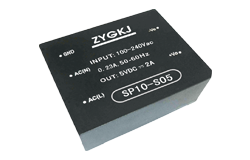বাতৰি
AC-DC Power Supply: Bridging the Gap Between Alternating and Direct Current
Author: ZYG Power Module Time: 2023-7-2
Introduction
In the world of electrical engineering, power supply plays a crucial role in ensuring the smooth functioning of various electronic devices. One such power supply that bridges the gap between alternating current (AC) and direct current (DC) is the AC-DC power supply. This article aims to provide an in-depth understanding of AC-DC power supply, its working principle, and its applications in different industries.
Working Principle of AC-DC Power Supply
AC-DC power supply converts the input AC voltage into a DC voltage suitable for electronic devices. The conversion involves three stages: rectification, filtering, and voltage regulation.
The first stage, rectification, is achieved using diodes. Diodes allow the flow of current in one direction and block it in the opposite direction. In an AC-DC power supply, the input AC voltage is passed through a rectifier circuit, which converts AC to pulsating DC. The pulsating DC signal contains both positive and negative half-cycles of the input AC signal.
The second stage, filtering, eliminates the pulsations from the rectified signal. This is done using capacitors, which store electrical energy and release it when the voltage drops. Capacitors smooth out the pulsations, resulting in a steadier DC voltage.
The final stage, voltage regulation, is necessary to ensure that the output DC voltage remains constant even with fluctuations in the input AC voltage. This is achieved using voltage regulators, which maintain a steady output voltage by adjusting the current flow.
Applications of AC-DC Power Supply
AC-DC power supply finds applications in a wide range of industries, including telecommunications, consumer electronics, industrial automation, and medical equipment.
In the telecommunications industry, AC-DC power supplies are essential for providing a stable power source to various communication devices such as routers, switches, and modems. These power supplies ensure uninterrupted connectivity and smooth functioning of telecommunication networks.

Consumer electronics, such as laptops, mobile phones, and televisions, heavily rely on AC-DC power supplies. These power supplies convert the AC voltage from the mains into the DC voltage required by these devices, enabling them to operate efficiently.
Industrial automation systems often require AC-DC power supplies to provide power to sensors, controllers, and actuators. These power supplies help in maintaining precise control over industrial processes, leading to enhanced productivity and efficiency.
Medical equipment, such as MRI machines, X-ray systems, and patient monitors, also utilize AC-DC power supplies. These power supplies ensure the reliable and continuous operation of critical medical devices, enabling healthcare professionals to provide optimal patient care.
Conclusion
AC-DC power supply acts as a bridge between alternating and direct current, converting the input AC voltage into a stable DC voltage suitable for electronic devices. Its working principle involves rectification, filtering, and voltage regulation. AC-DC power supplies find extensive applications in telecommunications, consumer electronics, industrial automation, and medical equipment industries. The reliability and efficiency provided by AC-DC power supplies are crucial for the smooth functioning of various electronic devices, contributing to advancements in technology and improving the quality of life.
পূৰ্ৱবৰ্তী: Introducing the DC DC Power Supply DM Series
এটাৰ পাচৰ: Unleashing the Power of Language: Exploring the Advantages of a Bidirectional Converter
প্ৰাসংগিক তথ্য
-
2023-7-12
The Evolution of Industrial AC-DC Converters: Advancements and Applications
Introduction Industrial AC-DC converters play a crucial role in converting alternating current (AC) power into direct current (DC) power. This conversion is essential for powering a wide range of industrial applications such as motor drives, power supplies, and renewable energy systems. Over the years, these converters have undergone significant advancements to meet the growing demands of the industrial sector. This article aims to explore the evolution of industrial AC-DC converters, highlighting the key advancements and their applications. Advancements in Industrial AC-DC Converters 1. Rectifier Circuits: Rectifier circuits are the fundamental building blocks of AC-DC converters. Initially, passive diode rectifiers were used, which were simple and cost-effective. However, these rectifiers suffered from poor power factor and low efficiency. To overcome these...
সবিশেষ চাওক -
2023-6-3
Exploring the functionality and advantages of bidirectional converters
In today's world of electronics, the need for efficient power management is rapidly increasing. With the growing demand for renewable energy sources, bidirectional converters have become a crucial component in energy storage systems, electric vehicles, and microgrids. Bidirectional converters are devices that can convert DC power into AC power and vice versa. They are designed to be able to transfer power in both directions, making them highly versatile and essential in applications that require efficient power management. Bidirectional converters can be classified into two types: AC-DC and DC-DC converters. AC-DC converters are used to convert AC power to DC power, while DC-DC converters convert DC power to DC power. The main advantage of bidirectional converters is their ability to transfer...
সবিশেষ চাওক -
2023-7-30
Bidirectional DC-DC Converter: A Versatile Solution for Efficient Power Conversion
Introduction In recent years, the demand for efficient power conversion systems has been increasing exponentially. With the ever-increasing use of renewable energy sources and the growing popularity of electric vehicles, the need for bidirectional DC-DC converters has become more critical than ever. This article aims to explore the significance of bidirectional DC-DC converters and their role in efficient power conversion. What is a Bidirectional DC-DC Converter? A bidirectional DC-DC converter is a power electronic device that allows the transfer of power between two DC sources in both directions. Unlike traditional unidirectional DC-DC converters, a bidirectional converter can convert power from a high voltage source to a low voltage source and vice versa. This capability makes it an invaluable tool for...
সবিশেষ চাওক -
2023-8-17
Efficient AC to DC Converter for LED Lighting: Transforming 12V AC into Reliable DC Power
Introduction In recent years, LED lighting has gained significant popularity due to its energy efficiency, long lifespan, and environmental friendliness. However, LED lights require direct current (DC) power to operate effectively, while most homes and buildings use alternating current (AC) power. To bridge this gap and enable efficient LED lighting, an AC to DC converter is required. This article explores the importance of these converters, their functioning principles, and highlights the benefits of using them in LED lighting systems. Importance of AC to DC Converters for LED Lighting AC to DC converters play a crucial role in LED lighting systems as they convert the incoming AC power to the required DC power. Without these converters, it would be impossible to...
সবিশেষ চাওক -
2023-8-21
AC DC Converter ZP Series manufacture: Efficient Power Conversion Solution
Introduction The world is rapidly advancing towards a more technologically advanced future, with an increasing demand for efficient and reliable power conversion solutions. In this regard, the AC DC Converter ZP Series has emerged as a game-changer, providing an innovative and efficient power conversion solution for various industries. This article will delve into the features, benefits, and applications of the ZP Series, highlighting its significant role in meeting the power conversion needs of the modern world. Features The AC DC Converter ZP Series stands out for its exceptional features that make it a preferred choice for industries worldwide. One of its key features is its high efficiency, which ensures minimal power loss during the conversion process. With an efficiency rating...
সবিশেষ চাওক -
2023-4-22
How to Differentiate Between an AC and DC Power Supply
Introduction Power supplies are essential components in many electronic devices. They convert the input voltage into the required voltage, current, and frequency to operate the device efficiently. There are two types of power supplies - AC and DC. AC stands for alternating current, while DC stands for direct current. In this article, we will differentiate between an AC and DC power supply. AC Power Supply An AC power supply is a type of power supply that receives alternating current as input and delivers alternating current as output. AC power supplies are commonly used in households and businesses as they are the standard for power supply from utility companies. They operate at a frequency of 50 or 60 Hz, depending on...
সবিশেষ চাওক


















